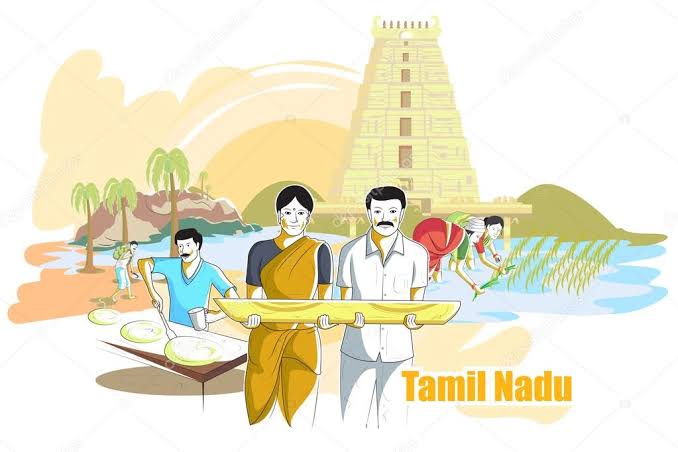
Source: Depositphotos
God created our World. It is the greatest boon given by the God to Mankind. According to Human Beings our World is divided into seven continents. It includes Asia, Africa etc. Among this India is one of the second largest countries in Asia according to its population. India is famous for its Culture. The Culture of India is ancient & different from place to place. In spite of different Languages, Arts & Crafts, Food, Dances, Music, Architecture etc our former Prime Minister coined the term “Unity in Diversity” to describe India. It deducted from “Discovery of India”. It was written by Jawaharlal Nehru. Even though India has several Cultures, “Tamil Culture” is excellent example which makes India Standout.
Tamil Culture
In India “Tamil Nadu” is in South. Tamil Nadu well known to be the “Cultural Capital of India”. It is called as “Tamil Culture”. Tamil Culture is followed by Tamil People. Tamil Culture is expressed in Language, Temples & its Architecture, Arts & Crafts, Dance & Music, Food, Dress, Religion, Philosophy etc.
Tamil Language
Tamil Language is followed by “Tamil People”. It is Simple & Easy to pickup. In 2004 Tamil was declared as a ‘Classical Language” by UNESCO. It is the prolonged remain Classical Language. Tamil is a part of UNESCO’S “Memory of the World Register” in 1997 & 2005. According to Archaeological Survey of India more than 55% of the epigraphical inscriptions are found in Tamil Language. It is the only language worshipped as a God. Also it is the official Language of many countries like Sri Lanka, Singapore, and India. Root words of many Languages are come from Tamil Language. It includes Sanskrit, Korean, Greek, and Latin. A Tamil Prayer Book named “Thambiran Vanakkam” which was first Printed & Published in “Tamil Language”. An Oldest Epigraphic Records found on Rocks & Hero Stones are from 3rd Century BC. It is the mass famed “Literary Language”. So every Tamil People are proud of the language.
Temples & its Architectures
In India Tamil Nadu is called “Land of Temples”. Approximately 33,000 ancient temples are found. It has many prominent Tamil temples. Awesome temples represent “Tamil Architecture”. It includes Brihadeshwara Temple, Meenakshi Amman Temple, Shore Temple, Kanchipuram & Kumbakonam temples etc.
- Brihadeshwara Temple was built by Rajaraja cholan. It is situated in Tanjore. Temple is made full of granite. In India it is one of the massive temples. It turned more than 1000 years old.
- Meenakshi Amman Temple is the most eminent tourist spot in Madurai. More over 33,000 sculptures are found here. “Dravidian Indian Style” was used to build. The temple has 12 Gopurams out of which 4 Gopurams are facing four directions.
- In Mahabalipuram “Shore Temple” is one of the old & finest rocks cut structural temple. It is situated at the shore of “Bay of Bengal”. In this temple blocks are made of Granites. It is the part of ‘Group of Monuments” at Mahabalipuram.
- “Temple City of Tamil Nadu” is “Kanchipuram & Kumbakonam”. In this Kanchipuram is one of the ancient “Pilgrimage Site” in Tamil Nadu. It has more than 100 temples. So, the foreign travelers have named it as “Land of Thousand Temples”. In 640 AD a Chinese traveler named Xuanzang visited Kanchipuram. He praised the people’s culture & tradition. Some of the eminent temples in Kanchipuram are as follows:
- Kailasanathar Temple
- Ekambareswarar Temple
- Kumarakottan Temple
- Varadaraja Perumal Temple etc
- Kumbakonam is one of the prehistoric temple towns & the peak tourist places in India. Kumbakonam means “Pot’s Corner”. The temples are celebrated for their elegant pillars, ingenious drawings and mythical stories.
Dance & Music
An essential part of “Tamil Culture” is not only Dance but also Music. Traditional Dances of Tamil Nadu includes several category; some of them are as follows
- Bharatnatyam
- Mayilattam
- Karakattam
- Kolaattam
- Oyilattam
- Kummi
- Kavadi Attam etc
Among these “Bharatnatyam” is a most famous Indian “Classical Dance”. It is originated in Tamil Nadu. It is a Multidimensional Art. It includes three elements like Nritta, Nritya, and Natya. It is still performed in temples. Today Bharatnatyam in India is most popular & widely performed dance. It is recognized by all over India & also World. It is the mass eminent form of “Tamil Music”. It is one of the precious stone of world music. It is go along with many of our cultural dances.
Arts & Crafts
Tamilians are fulfilled in the “Arts & Crafts” of Paintings, Spinning, Weaving, Jewelry, Pottery, Metalware etc.
- Tanjore Paintings are prints of rich “Cultural Heritage of India”. The Paintings are Ornaments with Glass Pieces, Pearls, Gold and Precious Stones. Nowadays Tanjore Paintings shape up to animals, birds, and human figures.
- The culture of Tamil Nadu can also see in traditional Jewelry. It includes Earnings, Bangles, Necklace, Chain etc. They use Gold, Diamond, Pearls, and other precious stones like Navaratna. All these things are wearer by both men and women.
- “Kanchipuram Silk Sarees” are weaved in Kanchipuram. It is most famed silk sarees in India. It has been recognized as a Geographical indication by the Government of India in 2005-2006. The most expensive Kanchipuram silk saree was made by Chennai Silks. The main drawing is a replication of Varma’s famed “Galaxy of Musicians”. It is grant by “Guinness Book of World Record”.
- Pottery is suitable proof of the heritage & cultural knowledge of Tamil People.
- In Tamil Nadu Metalware is not only popular but also used worldwide. It is made of copper & brass and also used for Pooja. Some of them are Lamps, Aarathi and Deepams.
“Tamilan Endru Sollada Thalai Nimirthu Nillada” said by peculiar person “Bharathiyar”. “Tamil People” have extraordinary taste for arts. The “Culture & Traditions” have been preserving by them over the years and are revealing till today in full enthusiasm. So, “Tamil culture” makes our India standout forever.
By Vaisali Vaisu


